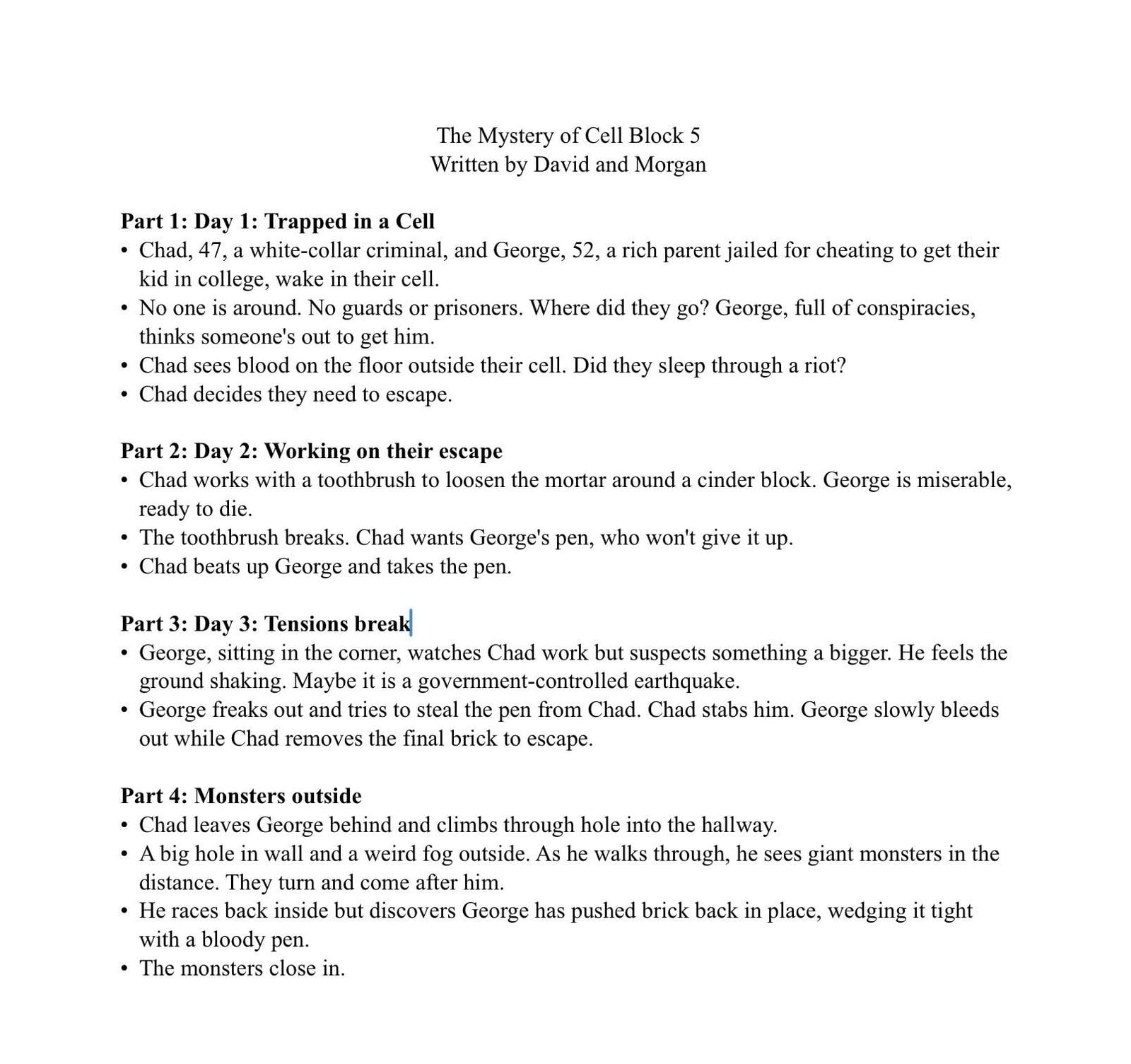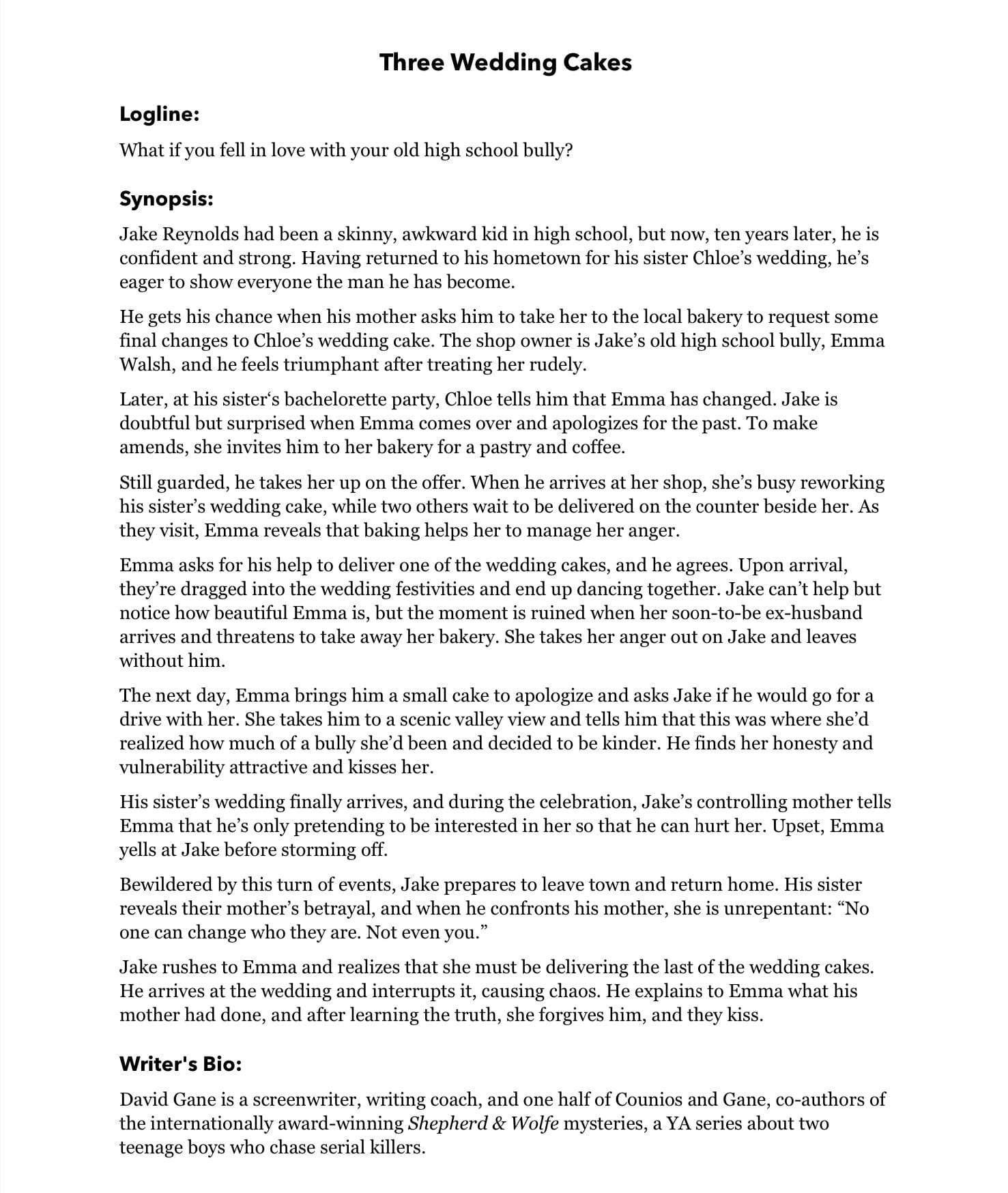Film 210: Week 12
Story Planning Methods
In this lesson, you’ll learn:
- Two main approaches to writing: pantsers vs. plotters
- Why outlining can enhance your writing process regardless of your preferred approach
- How to generate story ideas through rapid brainstorming
- How to build an outline using story beats and WOARO
- Guidelines for determining the right number of beats for different script lengths
- The one-paging method as an alternative outlining approach
- How outlining skills apply to all forms of writing beyond screenplays
Let’s begin!
Story Planning Methods
Outlining is a valuable skill for writers, though not everyone relies on it.
There are two main approaches to writing:
- Pantsers: Writers who create without a detailed plan, making it up as they go
- Plotters: Writers who map out their stories extensively before starting
Of course, there are also those who find a mix in-between.
Regardless of your preferred approach, learning to outline can enhance your writing process.
A well-crafted outline can give your story unity, shape, and help communicate meaning more effectively.
We’ll explore the benefits of outlining, offer practical methods for creating outlines, and introduce “one-paging” as an alternative approach. By understanding these techniques, you’ll have more tools at your disposal to bring your creative visions to life.
Rapid Idea Generation
Before you can outline, you need ideas. One of the most effective ways to generate story concepts is through rapid brainstorming—also known as “pitching to yourself.”
This technique involves setting a timer and generating as many story ideas as possible without self-censoring or judging. The goal is quantity over quality; among many ideas, you’ll often find unexpected gems.
The Process:
- Set a timer (15-30 minutes works well)
- Write continuously - don’t stop to edit or judge
- Don’t self-censor - silly ideas often lead to great ones
- Vary your approach - mix genres, characters, situations
- Focus on core conflicts - what does someone want and what’s stopping them?
Types of pitches you can generate:
- Quick pitches: One-line concepts that capture a basic want/obstacle dynamic
- “A man wants to go down a river but an angry beaver stands in his way”
- “A couple sits in their backyard. The world is about to end in 5 minutes”
- Developed pitches: More detailed concepts that include character and situation
- “A man heads downstairs for morning coffee and finds his old college roommate sleeping on his couch. He realizes he must help a man he’s barely spoken to in twenty years put his life back together”
Tips for effective brainstorming:
- Start with character types - then put them in unusual situations
- Combine unrelated elements - mix different genres or time periods
- Ask “what if” questions - take normal situations and add one strange element
- Use constraints - limitations often spark creativity
- Build on “bad” ideas - they often contain unexpected kernels of good stories
Remember: during brainstorming, there are no bad ideas. The goal is to get your creative mind flowing and discover story possibilities you wouldn’t have found through careful planning alone.
Why outline?
Outlines are powerful tools that create a roadmap for your story. They provide direction and clarity, helping you navigate through your writing with purpose.
An outline offers several benefits:
- It gives you a clear destination, showing where your story is heading
- It provides a daily guide, helping you focus on what to write in each session
- It allows you to define both large and small-scale layers of your story
- It helps you shape your characters’ WOARO (Want, Obstacle, Action, Response, Outcome)
- It encourages early consideration of themes, symbols, and imagery
Remember, an outline isn’t a constriction or a rigid formula. You’re not limiting your creativity—you’re giving it a structure to flourish within. Instead, think of it as a way to discover your story’s unique form and shape. It’s a flexible tool that still leaves plenty of room for creativity and spontaneous inspiration as you write.
Building an outline
Think of an outline as a roadmap through your story, built from story beats that propel the narrative forward.
These beats are units of action—either within a scene or across the entire story—that represent events, plot points, or steps moving your characters towards their ultimate outcomes. Story beats are built from the action and response cycles that create dynamic forward movement in your story.
When you write out your beats, make them active and transitive. They should show a character:
- Taking an action towards a want
- Responding to someone else’s action
Examples:
- Jane searches the house. She finds the money.
- Tom asks Bill to meet at the pier. Bill says, “No.”
It can help to break your beats into sections. This allows you to layer them (does this encompass the entire story, a single scene, or a beat within a scene?), define their intention (what is the purpose of this beat?), and label them with shorthand names that clearly identify what each one accomplishes.
If your script is long or has layers, it can be helpful to define the sections. For example, if the story is about a bank robbery, then maybe the big beats across the story are:
- Rob the bank
- Escape the police
- Double-cross the other criminals
Think of each section as a mini-story within your larger narrative, with its own beginning, middle, and end.
Another helpful tool is to use WOARO to shape the action. This allows you to look at every beat and layer of the story and ask whether it gets your character closer to or further away from their goal, ensuring each moment serves your larger narrative purpose.
For example: if the goal is to rob the bank and get the money, we know the story is complete when the main character escapes with it—or they don’t.
Finally, when writing an outline, include the ending. Show a resolution. Don’t aim for mystery or drama—aim for clear communication.
How many beats should you have?
The goal is to include enough beats to make writing your script easier. More beats create a more focused plan. Here are some general guidelines:
- For a 3-5 page script: aim for 6-15 beats
- For a 28-30 page script: try for 20-30 beats
- For a feature-length script (100-120 pages): aim for 80-120 beats
Consider breaking your stories into separate pieces (acts and sequences) and then identify the main beats within each.
Caution: Think about how long each story beat will take on the page. Writers often include too much story for their allotted page count.
Outline Example

Key points to note in this example:
- Connectivity: Notice how the outline connects story pieces from beginning to end, allowing readers to follow the narrative flow easily.
- Character details: The outline includes character descriptions and ages, providing crucial information for understanding the story and its dynamics.
- Structural elements: While not required, this outline uses markers like “Part 1, Part 2, etc.” to communicate the story’s structure clearly. This technique can be particularly useful for complex narratives or scripts with distinct sections.
One-Paging
One-paging forces you to make clear choices about your story. When you try to fit everything on one page, plot holes and weak cause-and-effect relationships become impossible to ignore—you simply can’t make a muddled story work in such limited space.
You can test this by reading your one-page aloud to others; their response will quickly reveal whether your story is clear and compelling.
While you can apply one-paging at different scales—starting big with the whole story, then going smaller to individual acts or beats if needed—the core approach remains the same.
One-paging is an alternative outlining method that my writing partner and I have experimented with to build our stories. The concept is simple: tell your entire story on one typed page. No more, no less.
Rules for One-Paging:
- Tell the full story, including the ending.
- Aim to fill the entire page. More details lead to a better understanding of your story.
- Focus on story progression. Each step should logically lead to the next.
- Ensure readability. You should be able to read it aloud to someone, and they should understand the complete story.
Note: For larger scripts, you won’t be able to include every story detail on one page. The challenge is to choose the most essential beats that convey a cohesive story within this limited space.
The one-page outline should function as a perfect pitch for your story. While you’ll likely tell more than show, you can include key dialogue if it’s crucial to the story.
I’ve successfully used one-pagers for scripts ranging from 5 pages to feature-length films. Here’s an example of a one-page outline for a feature:

Key Takeaways
- Outlining is a valuable skill that can enhance your writing process, whether you’re a pantser or plotter
- An outline provides a roadmap that gives your story unity, shape, and helps communicate meaning more effectively
- Story beats are units of action that should be active and transitive, showing characters taking action or responding to others’ actions
- Beat counts should match your script length: 6-15 beats for short scripts, 20-30 for medium scripts, 80-120 for features
- One-paging tells your entire story on one typed page and functions as a perfect pitch for your story
- Outlining skills apply to all forms of writing: scripts, short stories, novels, plays, essays, non-fiction books, and poetry
- Learning to find and create structure in your writing can save you years of frustration and elevate your craft across all genres